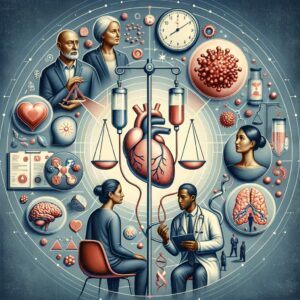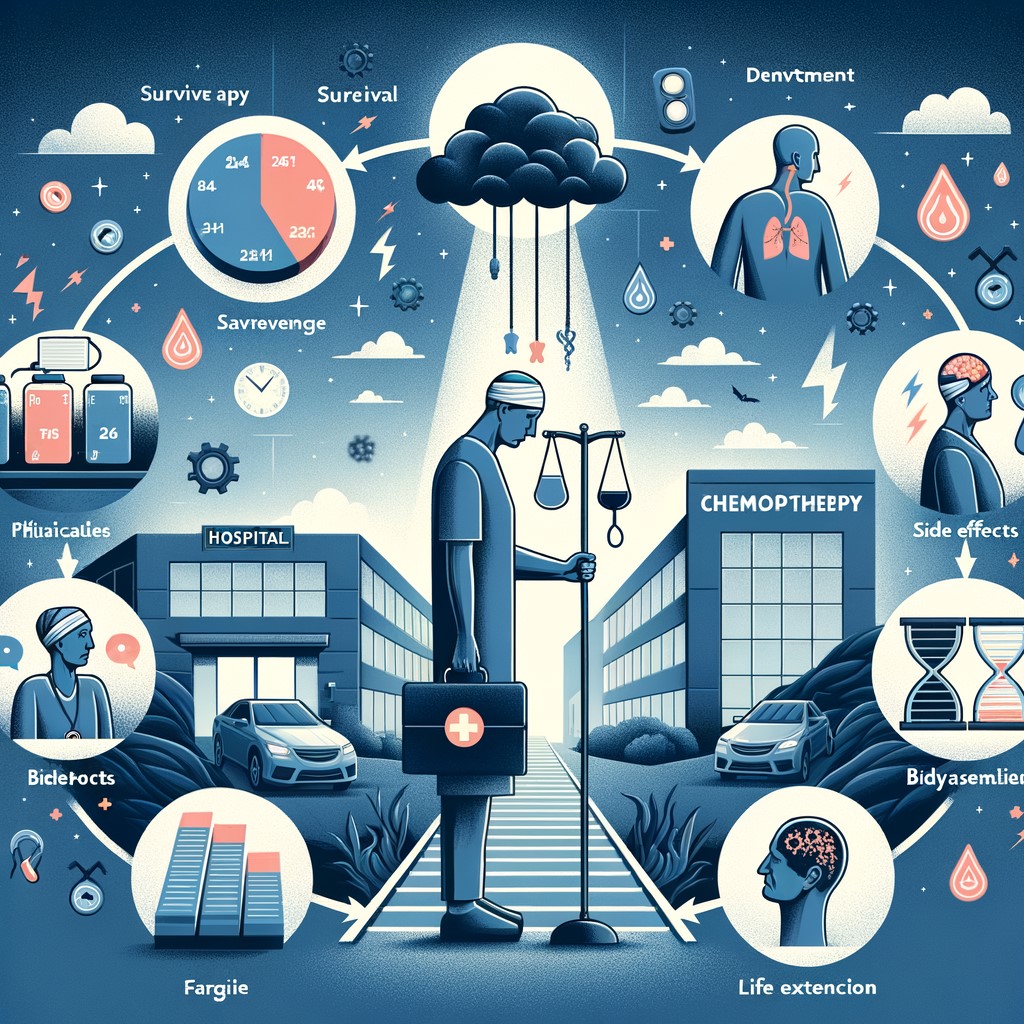Chemotherapy is a critical component in cancer treatment, offering hope and improved survival rates for many patients. However, navigating chemotherapy involves complex considerations beyond its medical effectiveness alone. Patients and their families must understand the potential benefits, limitations, and side effects on physical appearance and emotional well-being, as well as impacts on daily life and relationships. Additionally, comparing chemotherapy to other treatments such as radiation therapy can help clarify expectations regarding bodily strain. As individuals face decisions about initial or repeated courses of chemotherapy, it becomes essential to weigh immediate therapeutic advantages against long-term health implications carefully.

1. Evaluating the Benefits: How Long Can Chemotherapy Extend Your Life?
Chemotherapy remains one of the primary treatments for cancer, often significantly extending patient survival rates depending on various factors, such as cancer type, stage at diagnosis, and overall health condition. Clinical studies have demonstrated that chemotherapy can substantially prolong life expectancy in certain cancers like leukemia, lymphoma, breast cancer, colorectal cancer, and testicular cancer. For instance, patients diagnosed with early-stage breast or colon cancers who undergo chemotherapy may experience increased five-year survival rates by approximately 10% to 20%, compared to those who do not receive this treatment.
However, it’s important to recognize that chemotherapy’s effectiveness varies widely among individuals and types of malignancies. In advanced stages or aggressive forms of cancer where curative intent is less feasible, chemotherapy primarily serves a palliative role, aiming to alleviate symptoms and improve quality of life rather than significantly extend lifespan. Still, research shows that in metastatic cancers like lung or pancreatic cancer, which usually have worse outcomes, chemotherapy can still provide significant extra time to live, from a few months to over a year.
The decision-making process regarding chemotherapy involves careful consideration of potential benefits versus side effects and impacts on daily living. Oncologists utilize personalized assessments based on tumor biology characteristics (such as genetic markers), patient age, and general health status when determining expected outcomes from chemotherapy regimens. Therefore, even though it’s difficult to predict exactly how much longer someone might live with chemotherapy because every case is different, doctors use statistical information from clinical trials along with personal patient assessments to suggest treatment plans that aim for the best balance between benefits and risks.

2. Determining When Chemotherapy May No Longer Be Beneficial
Determining when chemotherapy may no longer be beneficial involves careful consideration of several critical factors, including the patient’s overall health status, treatment goals, and the progression or response of the cancer to previous therapies. Medical professionals typically assess whether chemotherapy continues to offer meaningful therapeutic advantages by closely monitoring tumor size, disease stability, symptom relief, and patient tolerance to ongoing treatments.
One significant indicator that chemotherapy might no longer provide benefit is a lack of measurable improvement in cancer control or symptoms after multiple cycles. If imaging studies and diagnostic tests consistently demonstrate disease progression despite aggressive therapy, healthcare providers may reconsider continuing with chemotherapy due to diminishing returns and increased risk for adverse effects.
Additionally, quality-of-life considerations play an essential role in determining continued treatment viability. Patients experiencing severe side effects—such as persistent fatigue, nausea, neuropathy, cognitive impairment (“chemo brain”), or compromised immune function—may find that further chemotherapy negatively impacts their daily functioning without providing substantial clinical benefits. In these cases, transitioning toward palliative care approaches focused on comfort management rather than curative intent can become appropriate.
Open communication between patients and oncology teams is crucial during this decision-making process. Discussions should include clear explanations regarding prognosis expectations with continued versus discontinued therapy options. Ultimately, decisions about discontinuing chemotherapy are highly individualized; they depend upon balancing potential survival gains against possible declines in physical well-being and emotional resilience associated with prolonged exposure to chemotherapeutic agents.

3. Quality of Life During Treatment: Can You Maintain Normalcy While on Chemo?
Maintaining a sense of normalcy during chemotherapy is an important consideration for patients undergoing treatment. Although chemotherapy can present significant physical and emotional challenges, many individuals successfully manage to continue daily routines and maintain their quality of life through careful planning and support systems.
The ability to sustain regular activities largely depends on the type, dosage, and frequency of chemotherapy administered, as well as individual health conditions. Patients often experience side effects such as fatigue, nausea, cognitive impairment (often referred to as “chemo brain”), or compromised immunity that may temporarily disrupt everyday tasks. However, proactive management strategies—such as scheduling treatments around work commitments or family events—can help minimize disruptions.
Healthcare providers frequently recommend lifestyle adjustments aimed at preserving energy levels and overall wellness throughout treatment. Such behavior includes maintaining balanced nutrition tailored specifically for chemo patients’ needs, engaging in moderate exercise approved by medical professionals, ensuring adequate rest periods, and utilizing stress-reduction techniques like mindfulness meditation or counseling services.
Additionally, leveraging available resources such as patient support groups or professional counseling can significantly enhance emotional resilience during this challenging period. Open communication with employers about flexible working arrangements also contributes positively toward sustaining professional responsibilities without undue strain.
Ultimately, while chemotherapy undoubtedly impacts daily living circumstances temporarily—and sometimes profoundly—it doesn’t necessarily preclude maintaining meaningful engagement in personal interests or social connections altogether. With careful planning and complete care from healthcare teams that focus on cancer treatments, along with strong support from family, people undergoing chemotherapy can still keep important parts of their normal lives during treatment.

4. Comparing Treatments: Is Chemotherapy or Radiation Harder on the Body?
When evaluating cancer treatments, patients often question whether chemotherapy or radiation therapy is more challenging for their bodies to endure. Both therapies have distinct mechanisms and side effects, making direct comparisons complex yet essential for informed decision-making.
Chemotherapy involves systemic treatment using powerful drugs administered intravenously or orally to target rapidly dividing cancer cells throughout the body. Consequently, it affects healthy cells as well, leading to widespread side effects such as nausea, fatigue, hair loss, weakened immunity, and gastrointestinal disturbances. The systemic nature of chemotherapy means that its impact can be extensive and prolonged across multiple bodily systems.
Radiation therapy differs significantly in its approach; it employs targeted high-energy beams aimed precisely at localized tumors or affected regions within the body. While this accuracy lowers the overall exposure to the body compared to chemotherapy, radiation can still cause serious local side effects, such as skin irritation or burns where the treatment is applied, swelling and inflammation of nearby tissues (radiation dermatitis), tiredness from the body’s efforts to repair damaged cells in the treated areas, and possible long-term scarring of the tissue.
Determining which treatment is harder on an individual’s body depends heavily on factors such as the location of the tumor, the stage of disease progression, and the individual’s health conditions before starting therapy. For cancers requiring broad systemic intervention, such as leukemia, chemotherapy may present greater overall physical strain due primarily to its comprehensive reach throughout bodily systems.
On the other hand, for solid tumors like breast cancer or prostate cancer, where radiation can be used to target the tumor specifically without harming much of the surrounding body, radiation may cause fewer overall side effects, even though patients might feel significant pain in the treated area during the sessions.
In the end, knowing these differences helps patients prepare for challenges with each treatment type while allowing healthcare providers to create better support plans that are specifically designed for each patient’s needs as they work together with medical teams to reach their recovery goals.

5. Physical and Emotional Effects of Chemotherapy on Aging and Appearance
Chemotherapy treatment can significantly impact both the physical appearance and emotional well-being of patients, often intensifying concerns related to aging. Physically, chemotherapy frequently results in noticeable changes such as hair loss, skin dryness or discoloration, brittle nails, weight fluctuations, and fatigue-induced alterations in posture or mobility. These visible effects can contribute to a patient’s perception of accelerated aging due to their sudden onset and pronounced visibility. Additionally, chemotherapy drugs may cause hormonal imbalances that further influence skin elasticity and overall vitality.
Emotionally, these physical transformations can deeply affect self-esteem and body image confidence. Patients undergoing chemotherapy commonly report feelings of anxiety or depression stemming from altered appearances that do not align with their previous self-image. The psychological toll is compounded by societal perceptions regarding illness-related changes in appearance; individuals may experience heightened sensitivity toward perceived judgments from others about their health status or age.
Additionally, cognitive side effects, commonly known as “chemo brain,” can worsen emotional distress by affecting memory, focus, and decision-making skills, which are usually part of normal aging but become more severe during treatment. This combination of cognitive impairment alongside physical manifestations contributes significantly to an individual’s sense of premature aging.
Addressing these challenges requires comprehensive support systems, including counseling services focused specifically on coping strategies for managing emotional stressors related directly to appearance changes caused by chemotherapy treatments. Furthermore, practical interventions like skincare routines tailored for sensitive post-treatment conditions or specialized nutritional guidance aimed at maintaining healthy weight levels play crucial roles in mitigating some adverse impacts experienced throughout this challenging period.

6. Managing Daily Life and Relationships During Chemotherapy Treatment
Chemotherapy treatment can significantly impact daily routines, relationships, and overall quality of life. Effective management strategies are essential to maintaining a sense of normalcy and emotional well-being during this challenging period. Open communication with family members, friends, and colleagues is crucial in setting realistic expectations about your availability and energy levels. Clearly expressing your needs helps those around you provide appropriate support without overwhelming you or inadvertently causing stress.
Establishing practical routines that accommodate the physical side effects of chemotherapy can help maintain productivity while minimizing fatigue. Prioritizing tasks based on importance allows for better time management; delegating responsibilities when possible further reduces unnecessary strain. Additionally, incorporating rest periods into daily schedules ensures adequate recovery time between activities.
Maintaining social connections is equally important for emotional health during chemotherapy treatment. While it may be tempting to withdraw socially due to fatigue or discomfort, staying engaged with loved ones provides valuable emotional support and combats feelings of isolation or depression commonly experienced by patients undergoing chemotherapy.
Professional counseling services or patient support groups offer additional avenues for managing relationship dynamics affected by cancer treatments. These resources guide addressing sensitive topics such as intimacy concerns within partnerships or navigating changes in familial roles resulting from illness-related limitations.
Ultimately, proactive planning combined with open dialogue fosters stronger relationships throughout the chemotherapy process—allowing individuals undergoing treatment to feel supported emotionally while effectively balancing their personal obligations alongside medical demands.

7. Beyond Initial Therapy: Repeated Courses of Chemo and Long-Term Health Implications
Repeated courses of chemotherapy, often necessary for managing recurrent or persistent cancers, present unique considerations regarding long-term health implications. While initial chemotherapy treatments are primarily focused on immediate cancer control and remission, subsequent rounds may carry cumulative effects that impact overall health more significantly. Patients undergoing multiple chemotherapy cycles can experience increased susceptibility to chronic fatigue, neuropathy, cognitive impairment (often referred to as “chemo brain”), and heightened vulnerability to infections due to compromised immune function.
Additionally, repeated exposure to chemotherapeutic agents may elevate the risk of secondary malignancies later in life. Studies have linked certain drugs used in chemotherapy regimens to a higher incidence of leukemia or other blood disorders years after treatment concludes. Cardiotoxicity is another critical concern; some chemotherapeutic medications can adversely affect heart function over time, potentially leading to cardiovascular complications such as congestive heart failure or arrhythmias.
To mitigate these risks and manage long-term health effectively, ongoing monitoring by healthcare professionals is essential following repeated chemotherapy courses. Regular follow-up appointments should involve thorough checkups, including heart tests, blood tests to catch blood-related issues early, and nerve exams for signs of nerve damage, along with proactive plans aimed at reducing negative effects.
Patients considering additional rounds of chemotherapy must weigh potential benefits against these cumulative risks carefully with their oncology team. Open communication about possible side effects allows patients and providers alike to make informed decisions aimed at optimizing quality-of-life outcomes while maintaining vigilance regarding long-term health impacts associated with repeated therapeutic interventions.
Conclusion:
Navigating chemotherapy requires informed decision-making based on an understanding of both its potential life-extending benefits and significant challenges. While chemotherapy can substantially improve survival outcomes for certain cancers, recognizing when treatment may no longer be beneficial is equally important to preserve quality of life. By proactively managing physical symptoms and emotional stressors through supportive care strategies—including counseling services, lifestyle adjustments, and open communication with loved ones—patients can maintain meaningful engagement in daily activities despite treatment-related disruptions. Ultimately, thoughtful consideration of all these factors helps ensure that choices surrounding chemotherapy align closely with each individual’s personal values and overall health goals throughout their cancer journey.

